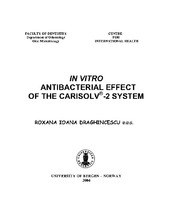In Vitro Antibacterial Effect of the Carisolv®-2 System
Master thesis
Permanent lenke
https://hdl.handle.net/1956/1306Utgivelsesdato
2004Metadata
Vis full innførselSamlinger
Sammendrag
Carisolv® (MediTeam, Gøteborg, Sweden) is a product marketed to dissolve carious dentin thus enabling minimal invasive treatment of dental caries. Studies have reported antibacterial effect of the first generation of Carisolv. Recently the second generation (Carisolv-2) was introduced. No information has been published about the antimicrobial effect of Carisolv-2. Aims: 1. To assess in vitro the in situ antimicrobial effect of the Carisolv-2 system on the bacteria in carious lesions. 2. To compare the type and quantity of bacteria from non-carious dentin treated by conventional drilling or by the Carisolv-2 system. 3. To evaluate the in vitro antimicrobial effect of the Carisolv-2 gel on selected cariogenic bacteria. Materials and Methods: Twenty-four extracted permanent teeth with caries (class I and II) not involving the pulp were collected after the patients’ consent and used in the study. Immediately after extraction and before Carisolv-2 application, one carious dentin sample was obtained from each of the lesions (samples 1) using slowly rotating sterile round burs. The teeth were then split aseptically in two halves along their long axis and through the middle of the carious lesions. The caries lesions of the two halves (n=48) were treated either with the Carisolv-2 system or by conventional drilling using sterile burs. Dental probes and a KaVo DIAGNOdent® laser apparatus were used to assess when caries-free dentin had been reached. Then, non-carious dentin was obtained in a standardized manner by sterile round burs from the bottom of the cavities after all carious dentin had been removed by drilling (samples 2) or Carisolv-2 treatment (samples 3). The dentin samples were weighed on a microscale balance and kept frozen in Greave’s medium until cultured aerobically and anaerobically on nonselective (blood agar) and on selective media (MS agar, Rogosa agar and CFAT agar). Although approximately the same volume of dentin was collected for each sample, the weight was slightly different. On an average the weight of the carious dentin samples was 0.15 mg/ml and that of the non-carious samples 0.20 mg/ml (p<0.01). Total and selective bacterial counts were calculated as colony forming units (cfu) per mg dentin. Bacterial speciation was based on growth on the selective media, biochemical tests for L. acidophilus and A. naeslundi and simple or nested PCR for S. mutans and S. sobrinus. Results: Samples 2 and samples 3 showed significantly (p<0.01) lower cfu/mg dentin counts on all culture media than did samples 1. Cfu/mg dentin of samples 3 were significantly (p<0.05) lower than those of samples 2, a difference most pronounced for anaerobic blood agar counts and CFAT counts. The Carisolv-2 gel inhibited the growth of all the cariogenic bacteria tested (S. mutans, S. sobrinus, L. acidophilus, A. naeslundi) with inhibition zones in the range of 16.5-35.0 mm and for A. naeslundi from 32.0 to 35.0 mm. Conclusion: Treatment of carious lesions by the Carisolv-2 system significantly reduced the bacteria in the adjacent non-carious dentin as compared to non-carious dentin obtained from lesions treated by drilling. The gel is the antimicrobial agent of the Carisolv-2 system.
Utgiver
The University of BergenOpphavsrett
Copyright the author. All rights reservedThe author
